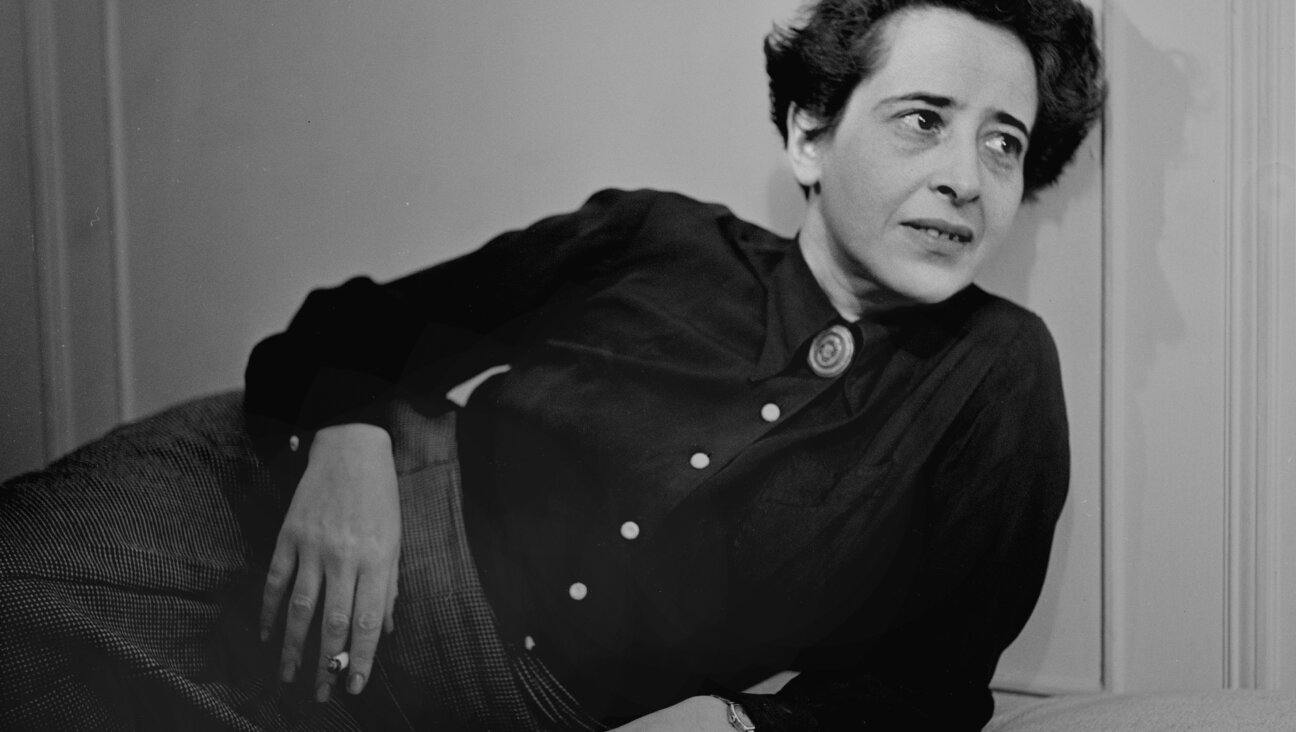WATCH: Ethiopian-Israeli Artist Creates Gorgeous Paintings to Celebrate Her Heritage

Image by Hirut Yosef

Ethiopian-Israeli artist Hirut Yosef Image by Hirut Yosef
Wide-eyed superwomen mesh with history in an eye-catchinge new exhibit by an emerging Israeli artist, currently on view in Harlem.
Bold, lively, and abstract, “Mulu and the Beta Clan” by Hirut Yosef features a range of medium from collage to painting to woodworking. Some prints are intimate photographs of her family members overlaid with graphic motifs of embroidery, weaving and textile design, a homage to the most powerful and influential women in her life.
“My biggest inspiration, where everything started, is thinking about my mother and my grandmother, and how amazing and strong women they were — especially in the Jewish Ethiopian community back in Ethiopia,” Yosef said.

Image by Hirut Yosef
The 37-year-old immigrated to Israel from Ethiopia when she was five and began this series, which is on display at Tsion Cafe in Sugar Hill until July 31, living in Turkey. A world traveler, Yosef’s work explores themes of immigration, belonging, and identity, seeking to build a visual bridge between Ethiopia and Israel as well as the other countries she’s lived, most recently, the United States.
As a student of fashion design at Tel Aviv’s Shenkar College of Engineering, Yosef realized that if she wanted to contribute something innovative to the artistic conversation in Israel, “I have to go back to my roots. I have to go back to where I came from and do the research there.”
This wasn’t always intuitive for the artist. “In the beginning I didn’t do anything with being Ethiopian and coming from a very rich culture. I totally ignored that. I’d introduce myself as Ruthie.”
Eventually, a teacher of hers at Shenkar inspired her to use her birth name, Hirut. She describes the process of returning to her original name as the spark which led her to travel back to Ethiopia, her birthplace.

Ethiopian-Israeli artist Hirut Yosef Image by Hirut Yosef
Yet, the first time she visited, she wanted nothing to do with the country, didn’t want to eat the food, she laughs. “My brother and my sister were like, Hirut, this is where you were born. These were the conditions you were born to. Why are you acting like a princess?” After her first trip, she fell in love with the place, and when she graduated from university and moved to Turkey, she started traveling to Ethiopia every year.
“That’s where my inspiration comes from — back home. So it’s combining two worlds, and introducing one world to another and building a bridge to find the place where I can actually express myself and share the story of my home, and the story of my mother and grandmother, because they cannot tell it.”

“Tatey” (grandmother) by Hirut Yosef Image by Hirut Yosef
Yosef does this visually, through interlaying black and while photographs of her family members with drawings of textile. “Through immigration and absorption, my mother and grandmother continued the traditional crafts of fine embroidery and basket weaving using colorful threads. Those simple geometric patterns have become a strong graphic motif in my paintings,” Yosef wrote.
“Four Women,” one of the largest pieces of this exhibition, represents her two of her older sisters, her mother, and grandmother. These women are abstract, their dress elaborate, vibrant pinks, oranges, and blues.
One woman lightly puts her finger on a second woman’s cheek, while a third woman’s arm wraps around the second woman’s shoulder. Through representing them in painting, the women become archetypes — superwomen.

“Four Women” by Hirut Yosef Image by Hirut Yosef
“Mulu” is a female name in Amharic which means “whole” and “perfection.” Yosef describes the term as her alter ego who, “represents the special women in my life and empowers them.” These four women fill the canvas, creating a monumental world unto themselves.
“The visual part came when I traveled with my brother in Ethiopia. We were driving for hours, and there was no one around, and then I saw these four women coming from nowhere. They just appeared, and they were so beautiful, smiling to us,” Yosef said.
It turned out they were bridesmaids on their way to a wedding, and Yosef and her brother stopped to speak with them. “When I came back home to Istanbul, I quickly sketched the outline of these women.”

Image by Hirut Yosef
One of the youngest of a family of 12, Yosef was the first Ethiopian to graduate from Shenkar. Her family now lives in the U.S., Israel, Ethiopia, and Canada.
At its core, “Mulu and the Beta Clan” is both a celebration and appreciation of origins, the physical place and her lineage of women. By combining her past with her contemporary influences, Yosef creates “a language of my own, redefining a place where the vast influences of my life can coexist.”

Image by Hirut Yosef
Leeron Hoory is a writer currently based in New York. Follow her on Twitter at @leeronhoory.
The Forward is free to read, but it isn’t free to produce

I hope you appreciated this article. Before you go, I’d like to ask you to please support the Forward.
Now more than ever, American Jews need independent news they can trust, with reporting driven by truth, not ideology. We serve you, not any ideological agenda.
At a time when other newsrooms are closing or cutting back, the Forward has removed its paywall and invested additional resources to report on the ground from Israel and around the U.S. on the impact of the war, rising antisemitism and polarized discourse.
This is a great time to support independent Jewish journalism you rely on. Make a gift today!
— Rachel Fishman Feddersen, Publisher and CEO
Support our mission to tell the Jewish story fully and fairly.
Most Popular
- 1

Opinion The dangerous Nazi legend behind Trump’s ruthless grab for power
- 2

Opinion A Holocaust perpetrator was just celebrated on US soil. I think I know why no one objected.
- 3

Culture Did this Jewish literary titan have the right idea about Harry Potter and J.K. Rowling after all?
- 4

Opinion I first met Netanyahu in 1988. Here’s how he became the most destructive leader in Israel’s history.
In Case You Missed It
-

Culture I have seen the future of America — in a pastrami sandwich in Queens
-

Culture Trump wants to honor Hannah Arendt in a ‘Garden of American Heroes.’ Is this a joke?
-

Opinion Gaza and Trump have left the Jewish community at war with itself — and me with a bad case of alienation
-

Fast Forward Trump administration restores student visas, but impact on pro-Palestinian protesters is unclear
-
Shop the Forward Store
100% of profits support our journalism
Republish This Story
Please read before republishing
We’re happy to make this story available to republish for free, unless it originated with JTA, Haaretz or another publication (as indicated on the article) and as long as you follow our guidelines.
You must comply with the following:
- Credit the Forward
- Retain our pixel
- Preserve our canonical link in Google search
- Add a noindex tag in Google search
See our full guidelines for more information, and this guide for detail about canonical URLs.
To republish, copy the HTML by clicking on the yellow button to the right; it includes our tracking pixel, all paragraph styles and hyperlinks, the author byline and credit to the Forward. It does not include images; to avoid copyright violations, you must add them manually, following our guidelines. Please email us at [email protected], subject line “republish,” with any questions or to let us know what stories you’re picking up.















